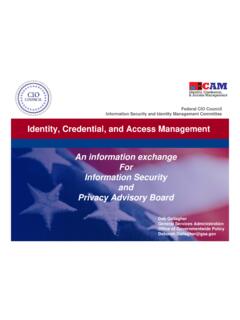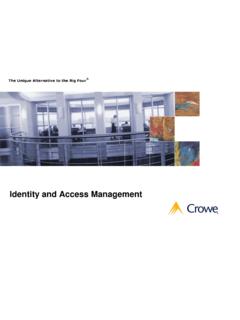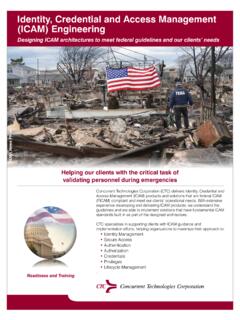Transcription of Guidelines for Derived Personal Identity Verification (PIV ...
1 NIST Special Publication 800-157 Guidelines for Derived Personal Identity Verification (PIV) credentials Hildegard Ferraiolo David Cooper Salvatore Francomacaro Andrew Regenscheid Jason Mohler Sarbari Gupta William Burr This publication is available free of charge from: I N F O R M A T I O N S E C U R I T Y NIST Special Publication 800-157 Guidelines for Derived Personal Identity Verification (PIV) credentials Hildegard Ferraiolo David Cooper Salvatore Francomacaro Andrew Regenscheid Computer Security Division Information Technology Laboratory William Burr Dakota Consulting, Inc. Silver Spring, MD Jason Mohler Sarbari Gupta Electrosoft Services, Inc. Reston, VA This publication is available free of charge from: December 2014 Department of Commerce Penny Pritzker, Secretary National Institute of Standards and Technology Willie May, Acting Under Secretary of Commerce for Standards and Technology and Acting Director Special Publication 800-157 Guidelines for Derived PIV credentials ii Authority This publication has been developed by NIST to further its statutory responsibilities under the Federal Information Security Management Act (FISMA), Public Law ( ) 107-347.
2 NIST is responsible for developing information security standards and Guidelines , including minimum requirements for Federal information systems, but such standards and Guidelines shall not apply to national security systems without the express approval of appropriate Federal officials exercising policy authority over such systems. This guideline is consistent with the requirements of the Office of Management and Budget (OMB) Circular A-130, Section 8b(3), Securing Agency Information Systems, as analyzed in Circular A-130, Appendix IV: Analysis of Key Sections. Supplemental information is provided in Circular A-130, Appendix III, Security of Federal Automated Information Resources. Nothing in this publication should be taken to contradict the standards and Guidelines made mandatory and binding on Federal agencies by the Secretary of Commerce under statutory authority. Nor should these Guidelines be interpreted as altering or superseding the existing authorities of the Secretary of Commerce, Director of the OMB, or any other Federal official.
3 This publication may be used by nongovernmental organizations on a voluntary basis and is not subject to copyright in the United States. Attribution would, however, be appreciated by NIST. National Institute of Standards and Technology Special Publication 800-157 Natl. Inst. Stand. Technol. Spec. Publ. 800-157, 33 pages (December 2014) CODEN: NSPUE2 Comments on this publication may be submitted to: National Institute of Standards and Technology Attn: Computer Security Division, Information Technology Laboratory 100 Bureau Drive (Mail Stop 8930), Gaithersburg, MD 20899-8930 Email: Certain commercial entities, equipment, or materials may be identified in this document in order to describe an experimental procedure or concept adequately. Such identification is not intended to imply recommendation or endorsement by NIST, nor is it intended to imply that the entities, materials, or equipment are necessarily the best available for the purpose. There may be references in this publication to other publications currently under development by NIST in accordance with its assigned statutory responsibilities.
4 The information in this publication, including concepts and methodologies, may be used by Federal agencies even before the completion of such companion publications. Thus, until each publication is completed, current requirements, Guidelines , and procedures, where they exist, remain operative. For planning and transition purposes, Federal agencies may wish to closely follow the development of these new publications by NIST. Organizations are encouraged to review all draft publications during public comment periods and provide feedback to NIST. All NIST publications, other than the ones noted above, are available at Special Publication 800-157 Guidelines for Derived PIV credentials iii Reports on Computer Systems Technology The Information Technology Laboratory (ITL) at the National Institute of Standards and Technology (NIST) promotes the economy and public welfare by providing technical leadership for the Nation s measurement and standards infrastructure. ITL develops tests, test methods, reference data, proof of concept implementations, and technical analyses to advance the development and productive use of information technology.
5 ITL s responsibilities include the development of management, administrative, technical, and physical standards and Guidelines for the cost-effective security and privacy of other than national security-related information in Federal information systems. The Special Publication 800-series reports on ITL s research, Guidelines , and outreach efforts in information system security, and its collaborative activities with industry, government, and academic organizations. Abstract This recommendation provides technical Guidelines for the implementation of standards-based, secure, reliable, interoperable public key infrastructure (PKI) based Identity credentials that are issued by Federal departments and agencies to individuals who possess and prove control over a valid PIV Card. The scope of this document includes requirements for initial issuance and maintenance of these credentials , certificate policies and cryptographic specifications, technical specifications for permitted cryptographic token types and the command interfaces for the removable implementations of such cryptographic tokens.
6 Keywords authentication; credentials ; Derived PIV credentials ; electronic authentication; electronic credentials ; mobile devices; Personal Identity Verification ; PIV Acknowledgments The authors, David Cooper, Hildegard Ferraiolo, Salvatore Francomacaro and Andrew Regenscheid of the National Institute of Standards and Technology (NIST), William Burr of Dakota Consulting, Inc., and Sarbari Gupta and Jason Mohler of Electrosoft Services, Inc., wish to thank their colleagues who reviewed drafts of this document and contributed to its technical content and development. Special thanks to the Federal Identity , Credential and access Management (FICAM) Logical access Working Group (LAWG) for the review and contributions to the document. Trademark Information All registered trademarks or trademarks belong to their respective organizations. Special Publication 800-157 Guidelines for Derived PIV credentials iv Executive Summary The deployment of PIV Cards and their supporting infrastructure was initiated in 2004 by Homeland Security Presidential Directive-12 (HSPD-12) with a directive to eliminate the wide variations in the quality and security of authentication mechanisms used across Federal agencies.
7 The mandate called for a common identification standard to promote interoperable authentication mechanisms at graduated levels of security based on the environment and the sensitivity of data. In response, the 2005 Federal Information Processing Standard (FIPS) 201 specified a common set of credentials in a smart card form factor, known as the Personal Identity Verification (PIV) Card, which is currently used government-wide, as intended, for both physical access to government facilities and logical access to Federal information systems. At the time that FIPS 201 was first published, logical access was geared towards traditional computing devices ( , desktop and laptop computers) where the PIV Card provides common authentication mechanisms through integrated readers across the federal government. With the emergence of a newer generation of computing devices and in particular with mobile devices,1 the use of PIV Cards has proved challenging. Mobile devices lack the integrated smart card readers found in laptop and desktop computers and require separate card readers attached to devices to provide authentication services from the device.
8 For some departments and agencies, the use of PIV Cards and separate card readers is a practical solution for authentication from mobile devices. Other departments and agencies may plan to take advantage of Near Field Communication (NFC) to communicate with the PIV Card from NFC-enabled mobile devices. These solutions are summarized in Section , Background, and provide the complete picture of mobile device PIV-enablement. NIST Special Publication (SP) 800-157 does not address use of the PIV Card with mobile devices, but instead provides an alternative to the PIV Card in cases in which it would be impractical to use the PIV Card. Instead of the PIV Card, SP 800-157 provides an alternative token, which can be implemented and deployed directly with mobile devices (such as smart phones and tablets). The PIV credential associated with this alternative token is called a Derived PIV Credential. The use of a different type of token greatly improves the usability of electronic authentication from mobile devices to remote IT resources.
9 Derived PIV credentials are based on the general concept of Derived credentials in SP 800-63-2, which leverages Identity proofing and vetting results of current and valid credentials . When applied to PIV, Identity proofing and vetting processes do not have to be repeated to issue a Derived PIV Credential. Instead, the user proves possession of a valid PIV Card to receive a Derived PIV Credential. To achieve interoperability with the PIV infrastructure and its applications, a Derived PIV Credential is a PKI 1 A mobile device, for the purpose of this document is a portable computing device that: (i) has a small form factor such that it can easily be carried by a single individual; (ii) is designed to operate without a physical connection ( , wirelessly transmit or receive information); (iii) possesses local, non-removable or removable data storage; and (iv) includes a self-contained power source. Mobile devices may also include voice communication capabilities, on-board sensors that allow the devices to capture information, and/or built-in features for synchronizing local data with remote locations.
10 Examples include smart phones, tablets, and e-readers. 2 While the PIV Card may be used as the basis for issuing other types of Derived credentials , the issuance of these other credentials is outside the scope of this document. Only Derived credentials issued in accordance with this document are considered to be PIV credentials . Special Publication 800-157 Guidelines for Derived PIV credentials v Table of Contents Executive Summary .. iv 1. Introduction .. 1 BACKGROUND .. 1 PURPOSE AND SCOPE .. 2 AUDIENCE: .. 3 DOCUMENT STRUCTURE .. 3 KEY TERMINOLOGY .. 4 2. Lifecycle Activities and Related Requirements .. 5 Derived PIV CREDENTIAL LIFECYCLE ACTIVITIES .. 5 INITIAL ISSUANCE .. 6 MAINTENANCE .. 7 LINKAGE WITH PIV CARD .. 8 3. Technical Requirements .. 10 CERTIFICATE POLICIES .. 10 CRYPTOGRAPHIC SPECIFICATIONS .. 10 CRYPTOGRAPHIC TOKEN TYPES .. 10 Removable (Non-Embedded) Hardware Cryptographic Tokens .. 11 Embedded Cryptographic Tokens .. 12 ACTIVATION DATA.



















